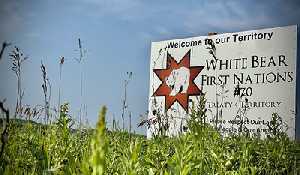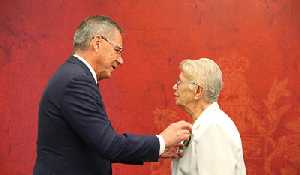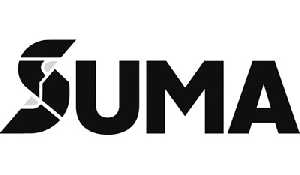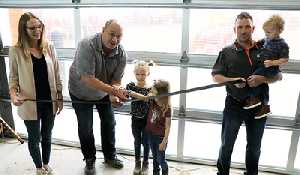Miners always felt safe during fire
October 2, 2012, 3:04 am
Kara Kinna


When a fire broke out underground at PotashCorp Rocanville last Tuesday, crews working underground, staff, and mine rescue teams did exactly as they were supposed to, and everyone went home safe, according to those who were involved with the situation.
The fire started underground at around 2 a.m. Tuesday morning when a wooden reel wound with metal cable ignited about 15 kilometres away from the mine shaft underground. Two other cable reels caught fire and began to burn.
Darwyn Wirth, one of the shift electricians working underground, was the first to come upon the fire and report it.
“I was driving down a travelway and saw a fairly large ball of flame,” he says. “At that point I realized I’m not going to try and fight it myself with a small extinguisher. I went immediately to a phone and called our emergency response number and then went to a refuge station.”
Wirth says his main concern was to alert the control room up on the surface of the situation so that emergency procedures could begin to kick into place.
“I was concerned about guys farther down because the smoke wasn’t coming towards me, the smoke would go with the airflow, and they would be in more danger than I would be. The big thing I wanted to do is make sure the control room knew that there was a fire so that everybody could be warned.”
Wirth’s call to the control room triggered a number of actions. Down below, sirens began to go off and lights began to flash, signalling an emergency, and alerting the men working the night shift below that they were to call in to the control room for more information.
Paul Stapleton, an underground supervisor who was working that night, says there’s no mistaking what to do.
“Once you see those lights go off, you’re well aware of what to do. It’s really a huge part of our training to know to call the control room for information,” he says.
“As a supervisor, your first thought is the safety of the guys you are in charge of, and can we get ahold of the guys who are working in that area (near the fire) and make sure they are safely stowed away in the a refuge station.”
Refuge stations are scattered throughout the mine, and are usually located near work areas. The refuge stations are sealed off from the rest of the mine, with their own ventilation systems and a hardwire phone connection. The stations are also stocked with water and food in case miners are trapped underground for a long period of time.
According to PotashCorp’s safety procedures, once everyone underground has entered refuge stations and is accounted for, they are in constant contact with the control room and given updates on what is happening outside in the tunnels.
Stapleton says, in this case, there was never any worry about whether or not they were safe.
“I personally wasn’t worried because I am also trained in mine rescue. I know they are really well rehearsed,” he says.
“I know lots of people can’t believe it, but for the most part no one was truly, truly worried because they knew we were safe and help was on its way.
“A lot of it was just waiting.”
Stapleton, along with eight other workers, was in the refuge station for about five hours. Mine rescue crews were able to evacuate his refuge station earlier than others because of its proximity to the mine shaft.
That still left 20 miners underground in three other refuge stations throughout the mine.
“When you are going home leaving guys behind it’s never a great feeling,” says Stapleton, who went home, then returned later in the day.
“Those were the guys I work with every day. I wanted to be there to greet them and bring them home,” he says.
Courtney Ryan was on the first mine rescue team that went down to battle the blaze. He says everything went as well as could be expected.
“Our mine rescue protocols are number one, safety of the team, number two, safety of the trapped workers, number three is to find and extinguish the fire, and number four is to rehabilitate the mine,” he says. “In this case we knew that everyone was accounted for, we knew exactly where the fire was, so our first job was to get to the fire, to try to extinguish it.
“Once we find out that there is an emergency, the protocol is to get ahold of all our guys. We also talked to Mosaic Potash (in Esterhazy), and if we need any of their help they support us. And once we have our three mine rescue teams, one ready to go down, one on standby, and one on their way, then we can proceed underground and check out what’s going on.”
Ryan says smoke is always one of the biggest concerns when fighting a fire underground in an enclosed space.
“Smoke is the worst risk underground. If you don’t have your fresh air and your exhaust separated, smoke goes where it’s not supposed to go and people become engulfed by smoke,” he says.
“In this case we had enough ventilation that the smoke didn’t back up too far, so we were able to approach the fire within 20 to 50 feet.”
The fire was finally extinguished just before noon on Tuesday, but that didn’t mean the other 20 miners could come to the surface yet. They waited it out while the area with the fire was cooled down by rescue crews and while smoke was ventilated from the mine.
Trent Harper was on one of the mine rescue teams that was sent down to battle the fire. Harper’s team was the fourth team that went down that day. He says there was still a risk of flare ups by the time they went down.
“When we were going down they said the fire was out, but once we got halfway out there we got a phone call and they said the fire had reignited,” he says.
While the wood and plastic had already burned, Harper says it took a while to cool down the spools of hot, metal cable. In the end, the cable had to be spread out with a scoop in order to help it cool down.
“All that was left was copper wire, so we took the scoop and lifted the copper wire and separated it a little bit and just cooled it,” he says.
“When I lifted the cable up with the scoop, I could see some sparks flying off it into the air, so I put some more water on it.”
Once there was no chance of the fire reigniting and the smoke was ventilated from the mine, the other 20 workers in refuge stations were brought up from underground around 7 p.m. on Tuesday night. Since starting their shifts at 6:30 p.m. on Monday, they had been underground for 24 hours.
Harper says all that matters is that everyone was safe.
“I think it went really well, no one got hurt and everyone was able to leave at the end of the day,” he says. “You can always replace cable, but you can’t replace the guys who work there.”
He says PotashCorp’s emergency training played a large role in everyone’s safety.
“If you know what you need to do and how you need to go about it, it will usually work out in the end,” he says.
Stapleton says the same thing.
“It went extremely smoothly,” he says. “Our training was very well rehearsed. Everyone from the supervisors to the mine rescue co-ordinators to the workers themselves did everything they were trained to do, and everyone did what they needed to do to get those guys home safe and sound.
“Our guys were safe right from day one and that’s because they were trained.
“Right from the top down, everyone did their job well and it went smoothly.”
Jack Chisholm, an underground operator at the mine, was in the refuge station closest to the fire, and farthest away from the mine shaft.
There were 11 workers in Chisholm’s refuge station, and he says none of them had any doubt that they would get out safely.
“I think we were better off than the people on the surface because we knew what was going on, we were well informed on the situation, and we were in good hands— there was no question of us getting out safe,” he says.
While the crew could smell smoke as they entered the refuge station, Chisholm says once inside they were perfectly sealed off and safe.
“We had more than we needed to survive as long as we needed,” he says. “They aren’t meant to be the Hilton. They are there to serve a purpose and it served it well.”
He adds that the hardwire phone connection in the refuge stations made the biggest difference for them.
“The phone was great, and being able to call out to our families, it was wonderful for PotashCorp to make that happen for us. I think that was the biggest morale thing for me—I was able to call my mother in Ontario.
“We’re in control where we are, we know our destiny. The people on the surface, all they’ve got to do is worry.”
Chisholm says he can’t stress enough how well the safety procedures worked in this case and how important they are. He notes that for some of the newer miners, like himself, who has been there less than three years, the whole experience was “an education.”
“It works,” he says. “The system works.
“They get two thumbs up. Everyone, from the control room to security pulled as a team, and it went well, it went awesome. We weren’t in any real danger once we were in the refuge stations.”
He says he was particularly impressed by the support shown by the Mosaic mine rescue team, who showed up to help out if needed.
The Mosaic mine in Esterhazy experienced a fire underground in 2006, and PotashCorp mine rescue crews attended back then to help fight the blaze.
“Their big comment was they were just returning the favor,” says Chisholm. “We’re all family, it doesn’t matter what company you work for, when you work underground long enough, you’re all family.
“I can’t say it enough, and there’s no real way to say it other than thank you.”
Chisholm jokes that the only real threat to him and the other men in the refuge station was boredom.
“We talked and tried to sleep and then got up and stirred the air, walked around and tried to tell jokes,” he says.
However, he says at no point did the men feel trapped.
“There was no point where any of us thought we wouldn’t get out. You just had to have a bucket full of patience and be cool.
“It was a minor inconvenience on the grand scale of things, and we had it better than the people on the surface—we were well informed.”
Stapleton says the same.
“We just kind of sat around and did lots of talking . . . it’s almost like going for coffee without coffee,” he laughs.
“The guys I talked to that were in the refuge station I took home, I don’t think throughout the whole ordeal that they felt trapped, especially when you have steady contact with the outside. People liked talking with their wives and girlfriends and mine control—they knew they were going home.”
Fortney pleased with outcome
Says fire will be used as a learning experience for PotashCorp Rocanville and other mines
Steve Fortney, the mine’s general manager, says part of the media furor over the mine fire last week was because people don’t understand mine refuge stations.
“It’s mostly a big story because of the misunderstanding of what it means to be in a refuge station,” says Fortney.
“It went very well. One of the things that the public doesn’t understand is the most critical phase is to get the people in the mine rescue stations, and once they are in there, essentially 80 per cent of the crisis is over for us.
“Once they are in the refuge station, 80 per cent of the emergency is dealt with.
They can literally stay there for days if they need to, although we can’t imagine a case where that would have to happen.
“When they are not in the refuge stations, that’s when we’re worried.”
In fact, Fortney says going and getting the miners after an emergency has passed is almost a non-event. Rescue crews simply drove up to the refuge stations in trucks and picked the miners up.
He says refuge stations are more about waiting out an emergency than anything else.
“You never take a person in a safe location and move them,” he says. “You will leave them there until safety has been restored to the mine.”
Fortney says it has been 15 years since PotashCorp Rocanville experienced a fire underground. Despite all the training that takes place on a monthly basis at the mine, he says only a real incident can test how well the mine’s emergency procedures are working.
“You don’t want it to happen,” he says. “You do a lot of training and planning and people dedicate a lot of time to it and you hope people will do the right things, but you don’t really know until it happens. So now we are feeling more comfortable with the things we have been doing.”
Fortney says the mine will learn from the experience and share their information with all the other potash mines in the province.
“All the mines co-operate. We’ll be reviewing this with every other mine and talking to them quite extensively about things that might have gone better, things that worked well and didn’t work as well.
“Whenever someone actually has a real emergency it’s important that we all learn as much as we can from them.
“We’ll spread as much knowledge as we can with everybody.”
So what did PotashCorp Rocanville learn in this situation?
“The mine is getting bigger and bigger and it takes a longer time to deal with everything,” says Fortney. “Even if we are expanding out west, it’s extremely important to make sure you expand the refuge stations with the mine.
“I think one of the things that caught us off guard was just the distance involved.”
Fortney says it took a long time to get water to the site of the fire and to refill the water tankers simply because the fire was located in a tunnel so far away from the main mine site.
The cause of the fire is still being investigated, but the mine is speculating that metal skid plates under the wooden reels of cable had something to do with it. The spools of cable, which are being used in the mine expansion, were being dragged through the tunnels on metal skid plates. The friction on the skid plates causes them to heat up.
Fortney says that the wooden reels with copper cable on them had been lifted off the skid plates two hours before the fire started, but mine officials do know that it was one of the wooden spools that ignited and started the fire.
He says the mine has already moved to take precautions against something similar happening again.
“Right now we’re not hauling any wooden reels around underground at all. That’s the biggest change that we’ve made immediately,” he says. “We’re not taking any further chances.”
In the end, Fortney says he’s simply happy that this particular emergency had a happy ending.
“I’m glad all the training paid off,” he says. “I’m glad the guys paid attention to the training and went to the refuge stations, and I’m glad we didn’t have to phone any families with any bad news.” Tweet



































